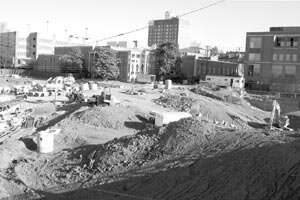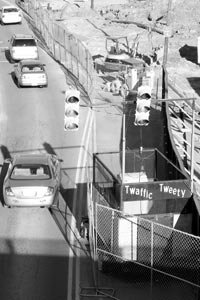Trim trimmed: Pavilion overruns nix bricks
A "disappointed" Board of Architectural Review has approved "fairly major" changes to the design of the Coran Capshaw-run amphitheater because of cost overruns, says city planner Mary Joy Scala.
The BAR okayed most– but not all– of the developer's requests March 22.
The biggest changes: elimination of bricks as trim on some steps and as the facing of amphitheater retaining walls. But not only the brick disappeared: the steps themselves have been dropped in favor of a concrete ramp.
"Having seating available in the off-season was important to the BAR," says Scala. "They envisioned a place for people to sit and eat lunch."
However, Ken McDonald, who's handling the pavilion project for Capshaw, is relieved that the steps are out of the picture. For one, he says, the ramp will improve access for people with disabilities.
"I never was quite comfortable with steps because it's not only an amphitheater, but a park and [it should be] more free flowing," says McDonald.
Even vocal design critic Candace Smith agrees a ramp might be an improvement. Smith, an architect, still believes the fabric-covered pavilion is oddly oriented and on too large a scale because City Council agreed to a 4,000-seat capacity before the BAR had a chance to see the plans.
The revised plans delete two retaining walls, reduce the size of a third one on Ninth Street, and change the material facing them to Redi-Rock, a faux stone described by its maker as "the industry leader in large block retaining walls."
"Charlottesville doesn't like retaining walls," says McDonald. "We did everything we could to mitigate the walls," which were originally slated to be concrete with brick trim.
Reducing the mass of those walls meant raising the amphitheater's elevation by five feet. And removing two of the walls allows for more lawn seating and the area to be "somewhat greener," says Scala.
The one Charlottesville Pavilion alteration the BAR rejected was removing two sidewalks. "You can imagine what people would do," says Scala. "They'd walk across the grass."
McDonald says the cost overruns are no surprise and no one is in panic mode about them.
He doesn't have a price tag yet because the revised plans are being cost estimated right now. "I'm very nervous about that," he says. "The changes affect everything you do, and it's a big, big change."
Will the changes affect the already pushed-back completion date? "You're not going to get a date out of me yet," McDonald replies.
McDonald says the city is still on schedule laying underground utilities, and that the steel arches and membrane fabric of the amphitheater will go up quickly because they're pre-fabricated.
But what about Loretta Lynn, who has scheduled a July 30 stop at the Charlottesville Amphitheater on her summer tour? "We're definitely talking to Loretta Lynn," McDonald says without elaboration.
The BAR also approved some changes to the federally funded transit center also under construction at the site. The BAR will allow a change in the columns and beams from Douglas fir to southern yellow pine. "We're going for a better energy rating using locally obtained materials," explains Scala.
All this construction– including "The Holsinger," a luxury condo tower rising in the former Fifth Street parking lot– has left the venerable C&O restaurant sandwiched between two temporary traffic signals and reduced Water Street to just one traffic lane.
And that has Daedalus bookstore owner Sandy McAdams irate. "It was supposed to be for two weeks," he says. "It's been 12."
Particularly galling to McAdams, who founded and later sold the restaurant, is the havoc the construction is creating for businesses, particularly the C&O, which is owned by his "spiritual brother," Dave Simpson.
"Shouldn't there be some penalty if a construction company runs into a delay?" asks McAdams. "They don't care."
Public works director Judith Mueller did not return phone calls by press time.

Still a gaping maw: The amphitheater loses its brick-trimmed steps and the gigantic retaining wall is reduced, but the Board of Architectural Review holds firm in its demand that sidewalks remain part of the project to keep pedestrians from cutting across the grass.
PHOTO BY LAUREN BROOKS

The "Twaffic Tweety" signal, which was to limit Water Street to one lane for only two weeks, is headed into week 12.
PHOTO BY LAUREN BROOKS
#